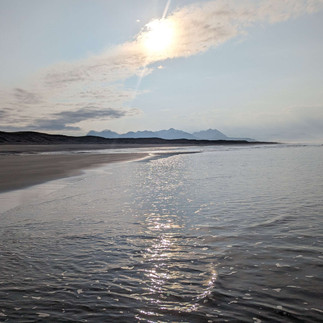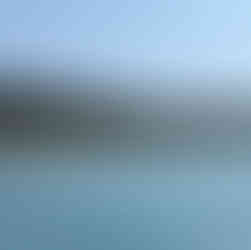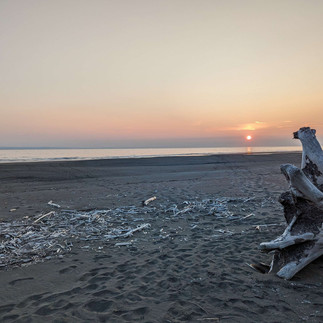Section 7: South to Sitka
- A Little Paddle

- Aug 22, 2023
- 9 min read
Updated: Aug 24, 2023
Having made it to Yakutat, the next step is to head Southward to Sitka. The trip is far from over, with 40 days left. And we have another important deadline, our ferry home leaves Sitka on August 22nd. We can't miss that. We do have plenty of time though, with 20 available days of paddling and only 250 NM to go, we left with lots of buffer for bad weather or surprise celebrations to occupy our time.

We started by spending a day, like we usually do, relaxing. After hanging out at Leonard's Landing, we met up with Krysia & Jim. These two have a wealth of backcountry experience, and know the area of Alaska we were paddling extremely well. They're paddlers, hikers, cyclists, and even bush plane pilots. The day we departed Yakutat was a bit of a mess. We had good intentions, waking up at 6 so Jim & Krysia could drive us to the Situk River to launch. We made pancakes, and then misplaced some gear, and had some technical issues with Navionics. In the end we decided to take a slow day, go for lunch, and paddle only 3 NM to the mouth of the Situk and hang out in the sun for the afternoon.

The following day, we did actually set off at 8am. It was low tide with 1m swell, so the waves at the mouth of the Situk were quite big. A local fisherman advised us to wait until high tide. We didn't heed his advice, and on leaving the Situk, I flipped my kayak. Thankfully I safely wet exited, collected my gear -- Nathan helped save one of my shoes -- and managed to get back in my boat in the breaking surf and paddle like stink out into deeper, calmer, waters. It was not a particularly cold day, and I was wearing my drysuit, so after taking a few minutes to reset my gear in my cockpit and on deck, I was ready to go. This could have been a lot worse.
Our second night on the way down we stayed on the Akwe river. The entry/exit is much nicer than Italio, as the river is bigger. There's also plenty of campable spots in the river Delta.
Shortly after we landed, we got a text from our new friends Krysia and Jim. "Where are you camped tonight?" So I sent them GPS coordinates, to which they replied "we're heading to the plane" A couple hours later, Jim & Krysia flew over in their bushplane. After a couple scouting passes, they opened one of the doors midair and dropped something out of the plane. Excitedly, Nathan paddled out to retrieve it. A 4 pack of Hazy IPA tallcans. Airdropped into the Akwe River, on the Gulf of Alaska. What a surreal moment.

We continued-on south, and stayed at the same camp sites on the East Alsek River, north of Cape Fairweather, and Kaknau Creek. On our way down, we had every intent of trying to find new camp sites to stay at. However, as we paddled along, we weren't able to see many different options that were landable in the ~1m swell at the given tides. We speculated that we'd gotten pickier, only landing at spots that looks both like nice camp sites and had breaking surf -- more comfortable to land in than dumping surf, which drops you hard onto the beach.
The weather on the way down was, for the most part, stunning. Lots of sun, lightly clouded to totally clear skies, and low wind. We were in a glorious high pressure system. This also meant the views were spectacular. Especially at and south of Dry Bay, when the mountains returned to view. We even had a couple days we were able to see the summit of Mount Fairweather. As you can imagine, this summit is known for only being visible in the fairest of weather. Paddling this coast southward is definitely preferable to northward, based purely on views.
Some photos from the beautiful trip south. Poutine, Glaciers, incredible sun.
Jim (from Yakutat) and Greg (from Gustavus) had given us a warning though. The long shore current, i.e. the current always running up the coast, ran north. This meant that heading south, we'd always be fighting something. When we stopped to pee from our boats, we noticed that we drifted northward at about 1 knot pretty consistently. This could have been due to the swell, wind, or other effects. But the consistency leads us to believe this was the current. Once paddling, however, we didn't notice it and our moving speeds don't reflect a current. The main effect of the long shore current we experienced was the northward movement of river mouths.
We did change-up a couple of our campsites as compared to the journey North; including paddling Cenotaph island inside Lituya Bay. This is a beautiful spot to camp. With lots of tasty berries. Paddling to the backside of Cenotaph was spectacular, as it opened up the view of the backside of Lituya Bay.
A beautiful day in Lituya Bay
The day we left Kaknau Creek to round Cape Spencer, things turned foul. The winds and seas were calm, but a squall moved through bringing torrential rain and a thunderstorm. At first, the thunder was more than 15 miles away. We managed to find a small rocky beach to hop off at -- totally uncampable -- and listened as the storm moved towards us. 10 miles. 4 miles. And then moved away again. After it was clear the storm had passed and was continuing to move east away from us, we hopped back in our boats and finished our paddle to Taylor Bay, out of the Gulf of Alaska.
Looking back on our northward and southward trips up the Gulf, from Cape Spencer to Yakutat, it's hard to tell if I'm wearing rose coloured glasses or not. There were definitely some hard days. We got stuck in thick fog. Had plenty of rain. There were scary moments, like rounding Dangerous River in pea soup fog using only a compass and our ears. We also lost gear to the surf, some of which -- like Nathan's hat -- was never recovered. We spent long days in the boat, 5 or 6 hours became our new normal. But the memories that stand out for me are how beautiful the coast line is, even when it stretches on as one beach forever. And how cool it was to see how well tracked the beaches were with wildlife. And how stunning the different glaciers and mountain ranges were. It was all so beautiful.

Exiting the Gulf immediately put is back into the land of people, which was an interesting switch to flip. Our first stop after Taylor Bay was Elfin Cove. Elfin Cove had a cruise ship in that day, so there were hundreds of German tourists flooding the town. The locals were busy accommodating their guests, and we had a few chats with people who thought we were funny-looking in our drysuits. We did meet a few locals, including Mary Jo, who'd raised her kids in Elfin Cove and lived there year round for most of her life, including now. It's very interesting to learn about the boom, bust, and slow rebirth of this fishing town. We also got to sticker trade with the local Girls Scout troop, our first sticker trade of the trip! It was also in Elfin Cove we learned about a storm brewing off the coast. Gale force winds were coming. So strong that the government had changed the fishery opening dates to allow fisherpeople to be on and off the water before the storm came through. People urged us not to leave Elfin Cove. Based on the forecasts we saw, we thought we had a couple days in which to move. Given that we were running low on food and needed to grab our resupply box that we'd mailed to Pelican, we moved on.
We arrived in Pelican the next day, very damp, but otherwise no worse for wear. Coming in to Pelican is surreal. It's a fishing town. The two main businesses are a fishing lodge and a fish processing plant. It sits mostly on the side of a cliff, with almost all buildings on stilts above the ocean. The exception to this is the school and schoolyard, where we slept for two nights under the covered basketball court -- ok'd by people in town, given that school was not in session and the storm was brewing.
We immediately made ourselves comfortable at Rosie's, the bar. It's my favourite bar in Southeast Alaska. The food is good, they've got a good selection of craft beer. And the bartender & chef are awesome. I also enjoyed that it's the only bar in town, so you get a mix of the local fisher people, local seasonal workers, year-round locals, and tourists to talk to. It's a wide variety of people, and the town stories quickly come out.
Pelican is a fishing town that was on decline, but seems to now be on the up and up. As commercial fishing and people moved into bigger towns, Pelican's population shrunk. Since the Highliner Lodge came in, they've bought a lot of property and re-opened the bar. Last year, for the first time in many years, a Grocery Store opened in town -- owned by a couple who winter in Washington state. Unlike most of the fishing towns we stopped in, Pelican felt bustling. Not with cruise ship tourists though, but with things. Forklifts moving pallets. Fishing boats unloading and resupplying. Float planes bringing tourists in and out. People driving ATVs into work in the morning. This was fun to experience, I'd highly recommend a stop in Pelican if you're coming through Southeast AK. It was definitely the most relaxing town stop we've had.
With knowledge that the storm was coming, we hustled off for a short paddle to the Bohemia Shelter after some delicious Biscuits and Gravy at Karen's. It was a short paddle, and we managed to escape the rain. All night we heard fishing boats motoring through the channel, positioning themselves for the fish opening the next day. It rained hard, all night. We were grateful for the wood stove to keep us warm and the shelter keeping us dry. The next morning, we took a leisurely 14 NM paddle to White Sulphur Hotsprings. With the storm blowing in, we figured we'd ride out the storm somewhere nice. Little did we know, this would be our last bit of paddling in Southeast Alaska.

We ended up spending a week at White Sulphur, hanging out with new friends and cute dogs, in the hotsprings and in the cabin. Nathan's written a post about all about that experience. On August 17th, we excitedly boarded the F/V Tammy Lin -- a family owned fishing vessel -- from White Sulphur Hotsprings to Sitka.
Boarding the Tammy Lin was quite an endeavor. First, we unloaded our kayaks and sent our gear over with the families gear in the Zodiac. All in all 4.5 Zodiac trips were involved. On the final Zodiac trip out, which included 2 children, 2 adults, and some gear, the Zodiac engine died. Nathan and I, already in our kayaks, towed the Zodiac and it's precious cargo out to the Tammy Lin. We then lifted ourselves on board, a maneuver we've become adept at, though the 5 foot swell added some challenge. After getting ourselves on board, it was a team effort to lift the kayaks from 3 feet below deck height, to 7 feet above deck height to the top deck, in one motion while hanging off the side of the boat. With the kayak faff sorted, Captain Dylan pulled anchor and we set off.

It took me exactly 7 minutes to start feeling sea sick. And this lasted for the entire 2 hour stretch along the outer coast. I kept my Drysuit and PFD on, since I spent that section on the outside deck. I was grateful when we transited through Imperial Passage, where we were shielded from the vomit inducing swell. After a few hours of motoring, we anchored behind Khaz Peninsula for dinner and sleep. Nathan fell right asleep, but it took me a while due to the residual seasickness.
Captain Dylan was up at 2am, and fired up the engines to get us motoring to Sitka. I'm very grateful and impressed that Dylan is able to pilot a boat in those seas with minimal sleep -- I was too seasick to function. I've got a lot of respect for the level of physical and mental performance of fisherman. I lay in bed, doing what I could to avoid getting up to puke, as that would have been game over. Once we entered Salisbury Sound, at around 4am. I managed to fall back asleep, and woke up just as we entered Sitka Harbor at 7am.

The trip on the Tammy Lin was a lot of fun. It was cool to see first hand what it was like, and learn more about the joys and hardships of working in fishing. The boat is, obviously, far more closed-in than a kayak. We got to spend time hanging out with the kids and families, chatting, and relaxing in a way we can't on a kayak. Being on the boat felt more like being in our own special little world, rather than out in it. I feel really lucky to have gotten this little taste of life on a fishing boat, definitely a highlight of the trip.
Paddling South to Sitka was full of entirely unexpected surprises. Beer-airdrops, fishing boat rides, and even meeting some friends of friends. We're looking forward to taking a few days to hang out in Sitka, the ferry home, and then complete the final leg of our journey from Bellingham to Victoria!




























Comments